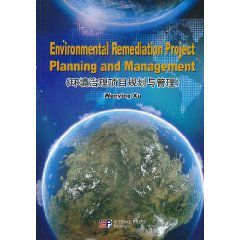內容簡介
 環境治理項目規劃與管理
環境治理項目規劃與管理《環境治理項目規劃與管理(英文版)》可作為高等院校環境科學與工程專業的教材,也可作為環保項目管理工作者的學習和參考用書。
圖書目錄
Preface
Chapter 1 Introduction
1.1 The environmental remediation industry in China
1.2 Regulatory overview
1.3 The changing market for remediation services
1.4 Modem project management
Chapter 2 Strategic Issues in Environmental Remediation
2.1 Significant environmental statues
2.1.1 The environmental protection law
2.1.2 Regulations related to the "three wastes
2.1.3 Other statues related to industrial waste management
2.2 Fundamentals of environmental remediation
2.2.1 The areas of potential project savings "'"
2.2.2 The four phases of environmental contamination
2.2.3 Factors that affect contaminant distribution and migration contaminant properties
2.2.4 Environmental assessment, techniques, and advancements
2.2.5 Remediation processes and advancements
2.3 Complicating factors in environmental remediation
2.3.1 Differing objectives of project stakeholders
2.3.2 Charged political nature of environmental remediation projects
2.3.3 Conflicting regulations
2.3.4 Effect of complicating factors on remedy selection
2.4 Scope management
Chapter 3 General Project Management Concepts
3.1 Environmental project management
3.1.1 What is a project?
3.1.2 Project management definition
3.1.3 Environmental project management
3.2 Project criteria
3.3 Project management resources
3.4 Project management functions
3.4.1 Project integration management
3.4.2 The four core functions (knowledge areas)
3.4.3 Four facilitating functions
3.5 Project management steps
3.6 Project management functions and boundaries
3.7 Project monitoring and controlling
3.7.1 Project monitoring
3.7.2 Project control
3.8 Project life cycle
3.8.1 Project phase activities
3.8.2 Significance of the phases
3.9 The environmental industry life cycle
3.10 The project planning and control cycle
3.11 General RPM responsibilities during RD/RA
Chapter 4 Reviewing Request for Proposal
4.1 Request for proposal
4.2 Importance of a high-quality proposal
4.3 Aproposal is a project
4.4 Recommended proposal format
4.5 Basis for the bid-no bid evaluation
4.5.1 The bid-no bid evaluation process
4.5.2 The proposal manager and team
4.6 Summarizing data
4.6.1 Categories of information
4.6.2 Site visit/data gathering
4.7 Identifying objectives
4.8 Specifications
4.8.1 Detailed design specifications
4.8.2 Performance-based specifications
4.9 Political, economical, and technological considerations
4.10 Stakeholder analysis
4.10.1 The.project stakeholder management process
4.10.2 Identifying project stakeholders
4.10.3 Identification of mission
4.10.4 Predicting stakeholder strategy and behavior
4.11 Initial risk identification
4.11.1 Definition of project risk
4.11.2 Project risk factors
4.11.3 Risk management
4.11.4 Contract strategy considerations
4.11.5 Overall project risks
Chapter 5 Assembling Project Teams
5.1 Identifying key project personnel
5.1.1 Skill sets required to perform tasks
5.1.2 Typical project team
5.1.3 Assembling a technical review team
5.1.4 Availability of personnel
5.1.5 Commitment and leadership
5.2 Team planning and geographical distribution
5.3 Project work plan completion/linear responsibility chart
5.4 The project office and location
Chapter 6 Developing a Work Breakdown Structure
6.1 Definition of work breakdown structure
6.2 Work breakdown structure formats
6.2.1 Tree diagram format
6.2.2 Indented outline format
6.3 Work breakdown structure functions
6.4 Work breakdown structure specifications
6.5 Techniques for WBS development
6.6 Scope of work based on the work breakdown structure
6.7 Risk management considerations
Chapter 7 Diagramming/Scheduling
7.1 What is so difficult about scheduling
7.2 Schedule definition
7.3 Project time management
7.3.1 Activity sequencing
7.3.2 Duration estimating
7.3.3 Schedule development
7.3.4 Time control
7.4 Method of developing an optimum schedule for an accelerated project
Chapter 8 Cost Estimating
8.1 Project cost management
8.2 Cost classification
8.2.1 Direct cost
8.2.2 Indirect cost
8.3 Types of cost estimates
8.4 Information required for assigning resources/cost estimating
8.5 Impact of resource assignment on duration estimating
8.6 General process for assigning resources/cost estimating
8.7 Contingency estimating on lump sum contracts
Chapter 9 Earned Value Analysis
9.1 Earned value analysis
9.2 Definition of terms
9.3 Variance calculations
9.4 Graphical earned value analysis
9.5 Cost and schedule forecasting
9.5.1 Calculation of estimate at completion
9.5.2 Calculation of estimated duration at completion
9.6 Causes of project variance
Chapter 10 Advanced Project Planning and Risk Management
10.1 Understanding quantitative decision analysis
10.2 Structuring the decision problem
10.2.1 Decision tree
10.2.2 Influence diagrams
Chapter 11 Remedial Investigation/Feasibility Study (RI/FS)
11.1 Scoping
11.2 Site characterization
11.2.1 Define site physical characteristics
11.2.2 Characterize sources of contamination
11.2.3 Characterize nature and extent of contamination
11.2.4 Perform data analysis
11.2.5 Define contaminant fate and transport
11.2.6 Define contaminant-and location-specific requirements
11.2.7 Evaluate additional data needs
11.2.8 Preliminary site characterization summary
11.3 Development and screening of alternatives
11.4 Treat-ability studies
11.4.1 Level of treat-ability studies
11.4.2 Suggested content for a pilot-scale treat-ability study work plan
11.4.3 Determining the need for treat-ability studies
11.4.4 Timing of treat-ability studies
11.4.5 Treat-ability study goals
